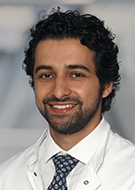Generalist or Subspecialist? No Wrong Answer for Trainees Thinking About the Future
Complex decisions face trainees as they plan their professional careers



Deciding which path to take with radiology education can be one of the most difficult choices for a trainee and might have implications for the remainder of their career. Trainees can pursue a fellowship to subspecialize in a particular field of radiology, or remain a generalist working in many different fields, both of which can take a radiologist’s career in different directions.
Haidara Almansour, MD, MEng, currently a fifth-year radiology resident at the Department of Diagnostic and Interventional Radiology at the University of Tübingen in Germany, recently explored the factors that go into this choice in an article published in Radiology.
“There’s no right or wrong answer, but these decisions are always met with a little bit of caution because it is a big decision,” Dr. Almansour said.
Personal and Professional Factors to Consider
Radiologists in training should weigh several factors when making the decision, according to Dr. Almansour.
Financial considerations such as future salary against the current level of student debt should be weighed. In addition, it’s important to think about your personal interest in the subspecialty, what type of practice setting you’d prefer, work-life balance, and if interested, what are the possibilities for international mobility. Socially, it’s important to consider your partner’s career and proximity to family.
Of those, practice setting can have the most influence on a future radiologists’ career. For example, working in private practice versus academia would have different implications for all the other factors on the scale, Dr. Almansour noted, but personal interest should not be overlooked.
“At the end of the day, if you’re not enjoying what you’re doing on a daily basis, then getting up and going to work doesn’t make that much sense. You have to do something you enjoy in order to withstand the challenges that come with it,” Dr. Almansour said.
That goes hand in hand with work-life balance and the understanding that different subspecialities may have different requirements. For example, an interventional radiologist working at a hospital may have overnight on-call duties versus a breast radiologist who works more regular hours.
“When pondering their path in radiology, it is important for trainees to think about their long-term goals,” said Erin Gomez, MD, assistant professor and program director, diagnostic radiology and molecular imaging residencies at Johns Hopkins Hospital, Baltimore. “What type of environment do they envision themselves practicing in and how important is it to be a subject matter expert in a specific area? They should also consider if there is developing technology or knowledge regarding specific modalities or disease processes on which they would like to focus.”
“Be prepared for change. Explosive technological changes occur regularly in the field of radiology. Know how to adapt your practice, be a self-driven lifelong learner and be ready to seek new training as new modalities and technology develop. A radiologist’s first job out of training is often not the last job they’ll ever have, so make sure you have the training you need for the next job, not just the first one.”
CHARLOTTE S. TAYLOR, MD
Prepare for Shifting Career Goals and Changing Technology
In the U.S. it is more common for trainees to subspecialize and work toward becoming an expert in their field. Dr. Gomez said nearly all John Hopkins residents go on to complete subspecialty fellowships, but they may still find work as generalists.
“The benefit of being a generalist is that it certainly opens up a wealth of opportunities in terms of employment. Many practices are looking for radiologists that are willing and able to read a wide variety of cases, especially if they are contracted to provide services for multiple hospitals or health care systems,” Dr. Gomez said. “Having the skillset to read everything from breast imaging to neuroradiology permits work that is more often required in teleradiology. Being a generalist also allows one to maintain skills related to multiple imaging modalities and anatomic regions.”
Charlotte S. Taylor, MD, assistant professor of radiology and program director, diagnostic radiology residency at the University of Mississippi Medical Center in Jackson, MS, said having more general skills can also help trainees find a job anywhere, including smaller hospitals or more rural settings where it is important to have knowledge on many topics, but to keep in mind that career goals may shift over time.
“Be prepared for change. Explosive technological changes occur regularly in the field of radiology,” Dr. Taylor said. “Know how to adapt your practice, be a self-driven lifelong learner and be ready to seek new training as new modalities and technology develops. A radiologist’s first job out of training is often not the last job they’ll ever have, so make sure you have the training you need for the next job, not just the first one.”
Dr. Gomez agreed, saying either choice will open doors for trainees in the field of radiology, which is constantly evolving.
“We can only dream of what the state of the specialty as a whole will look like 20 to 30 years from now,” Dr. Gomez commented. “Radiologists have any number of exciting options to choose from in terms of their career paths, and cutting-edge technology and research are integral parts of the inevitable advancement of the field. Consider the role that you see yourself playing in this evolution and which unique skills and attributes you possess. This may help you select the path that will lead you to provide the highest quality care for your patients and find the most satisfaction in your career as a radiologist.”
After weighing all the different factors at play and considering his options, Dr. Almansour said he is looking forward to pursuing an interventional radiology fellowship at the University of British Columbia in Vancouver, Canada.
“You can never predict the future or the opportunities you will get,” Dr. Almansour said. “You have to have a very solid base of skills and every trainee should focus on that, so no matter where you go in the future, you will be standing strong.”
For More Information
Access the Radiology commentary, “Fellowship Training: Navigating the Decision to Be a Generalist or a Subspecialist—Radiology In Training.”
Read previous RSNA News stories about radiology training:
- Engineering-Based Medical Training: The Catalyst for a Health Care Revolution
- The Growing Popularity of IR/DR Certification
Credit: Nestor Rizhniak/Shutterstock.com